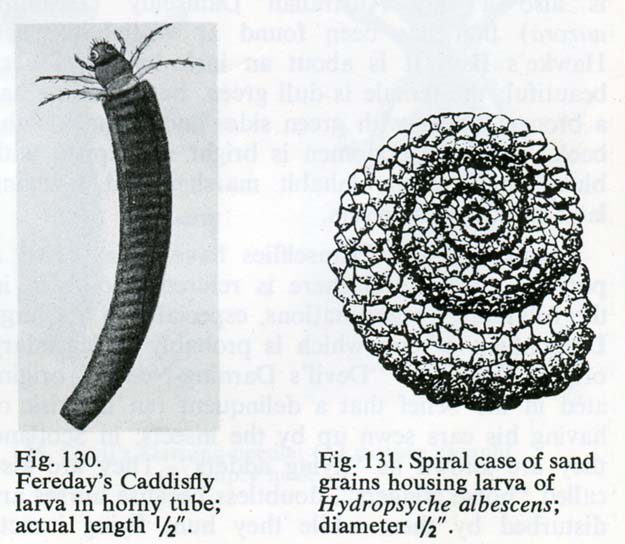David Miller, Common Insects in New Zealand, Wellington, A. H. & A. W. Reed, 1971, p. 55-57.
Caddisfly larvae are most numerous of aquatic insects devoured by trout ; most are vegetarians, and are know to anglers as « caddis-worms’ » The elongate body has well-developed thoracic legs and a pair of hooked anal processes which aid locomotion, or serve to secure a hold in the habitation constructed by many species (fig 128). The larvae are, of three kinds : those that do not construct a habitation ; those that spin and live in silken tunnels and pocket and also among stones ; small pebbles, and fragments of vegetation, or simply utilise hollow twigs…/.. The most conspicuous caddisfly construct cases of various kinds which they drag about whilst feeding, the head, thorax and legs projecting from the front end. A large species abaut 3/4 inche long (Triplectides obsoleta, fig 129.) lives either in a hollow twig fragment, or builds a case of leaf and twig particles ; it is vegetarian, and frequents pools and sluggish streams. On the other hand, there are minute « purse » caddis-fly larvae (e.g. paroxyethira hendersoni) inhabiting little purselike horny cases attached to plant foliage in ponds, lakes, and streams ; the case of a smaller species (Oxyetheria albiceps) is bottle-shaped. The larvae of both species feed on slime algae.

One of the larger and abundant case-bearers (Pycnocentrodes aureola) inhabits mosses in stony and silted streams of moderate, or little, current. The case, neraly ½ inche long, is tubular and covered with sand grains, or minute pebbles ; when about to pupate, the larva closes both ends, except for slits to allow the passage of water. The larva of another species (Olinga feredayi) forms a curved, brownish, translucent and homy, tubular cases (fig.130), usually found at the margins of swift streams. Other kinds (e.g. Helicopsyche albescens) construct cases of sand grains in the form of flat, spiral shells (fig. 131) found on the surface, or in crevices, of stones according to the rapidity of the streams. And an interesting species (Philanisus plebejus) lives in coastal rock pools between tide marks ; the larvae feed on coraline algae, small pieces of which are used in the construction of the cases.
